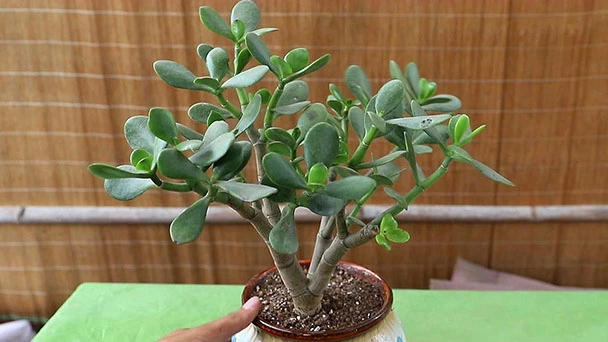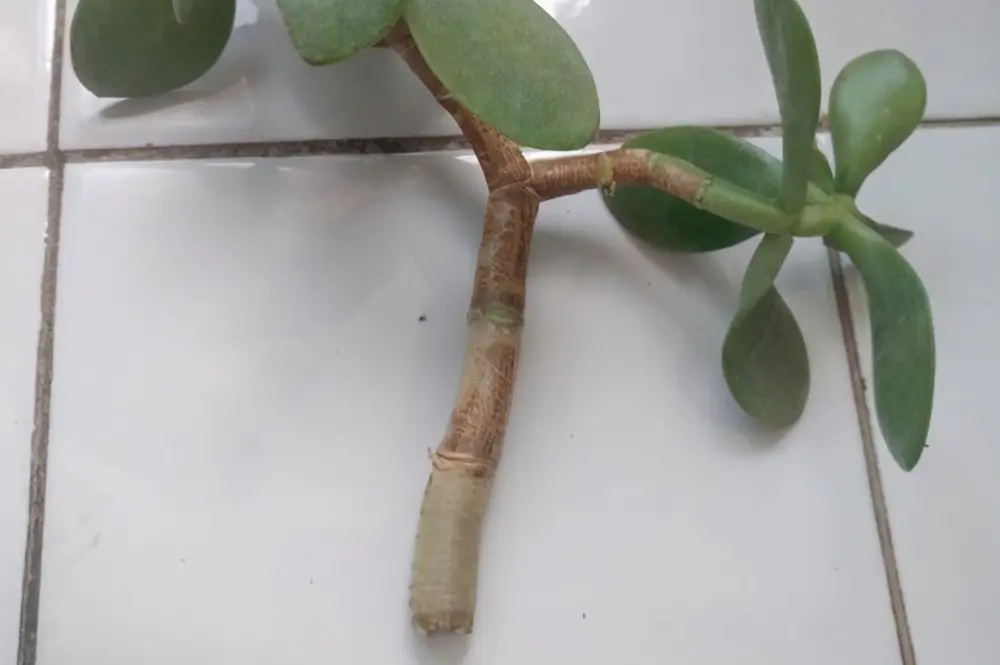What Are Jade Plant Common Diseases
Written by Ivy
Apr 29 2022

Jade plant is tall and tough in shape, and the whole plant is green and fresh. So naturally, it is also the first choice for many families to cultivate potted plants, but we often encounter the problem of plant diseases and pests in the process of propagating jade plant, which is really a headache. Once affected by diseases and pests, the ornamental ability of jade plant is greatly reduced. What are the common pest control methods of jade plant? Let's have a look.
Control Method: when we find a small amount of aphids on jade plant, we can brush them off with a brush dipped in water or with a thin aqueous solution of washing powder. Or put the cloth strip or cotton yarn dipped in dichlorvos liquid on the soil surface of the basin, cover the plant with the basin bottom with plastic film bag, seal it for 24 hours and fumigate it. In addition, we can spray insecticide to kill aphids on jade plant, or spray with 600-800 times of balm. You can also soak cigarette butts or cigarette dust in water, dilute it with its filtrate and spray it, or mash it with 20 grams of onion, add l o0 ml of water, soak it for 24 hours, filter and spray it. Finally, we can dig ditches in the basin and bury 15% tiemieke granules. Put 0.5-1g (l5cm diameter flowerpot) into each pot. Cover and water after burial.
Control Method: we can spray 40% Omethoate emulsion 1000 times, but because the scale insects are wrapped in crustaceans, sometimes the drug spraying is not very effective. At this time, we can gently and repeatedly wipe the jade plant disease strain with alcohol to remove the scale insects, and it can be very clean and thorough. For example, when wiping the diseased leaves of orchids with alcohol, it can not only remove the scale insects, but also completely kill the larvae that cannot be seen clearly by the naked eye. In the second year, few scale insects are found. This method is simple, safe and effective.
Control Method: if we find that there are not many brown soft scale insects in jade plant, we can brush them with a brush, scrape them with bamboo chips, or even wipe them with burlap. Of course, pay attention to the timely treatment of the brushed insects. In addition, we can combine pruning appropriately, cut off the insect branches and leaves, and then burn them in a centralized manner; If there is no way to deal with the above methods during the peak hatching period, use 100 times of 95% oil emulsion and spray it once every 7-10 days for 3-4 times.
Control Method: we should use sterilized soil before spreading jade plant. When applying fertilizer, we must apply fully decomposed organic fertilizer, otherwise it may cause rot disease. In addition, jade plant rot is mainly caused by ponding. It should be watered properly to avoid ponding in jade plant basin soil and keep the basin soil breathable and permeable. After the disease occurs, the seriously infected plants should be removed in time, and then the diseased parts should be coated with medical ointment.
Control Method: we should remove the residual leaves of jade plant in time; 0.5% ~ 1% Bordeaux solution (or 50% carbendazim 1000 times solution) can be sprayed in the early or late stage of the disease.
Control Method: we should strengthen conservation and increase the application of phosphorus and potassium fertilizer; In the early stage of jade plant disease, it can be sprayed with 0.3% ~ 0.5% equivalent Bordeaux solution (or 800 ~ 900 times of 60% mancozeb solution, or 1500 times of 70% tobuzin solution).
1. Aphids
Aphids damage the young and tender parts of jade plant. Sucking the juice of stems, branches and leaves of jade plant will affect the normal growth of jade plant. Moreover, the secretion of jade plant is easy to attract ants and lead to the occurrence of other diseases. Once found, it should be controlled in time.Control Method: when we find a small amount of aphids on jade plant, we can brush them off with a brush dipped in water or with a thin aqueous solution of washing powder. Or put the cloth strip or cotton yarn dipped in dichlorvos liquid on the soil surface of the basin, cover the plant with the basin bottom with plastic film bag, seal it for 24 hours and fumigate it. In addition, we can spray insecticide to kill aphids on jade plant, or spray with 600-800 times of balm. You can also soak cigarette butts or cigarette dust in water, dilute it with its filtrate and spray it, or mash it with 20 grams of onion, add l o0 ml of water, soak it for 24 hours, filter and spray it. Finally, we can dig ditches in the basin and bury 15% tiemieke granules. Put 0.5-1g (l5cm diameter flowerpot) into each pot. Cover and water after burial.
2. Scale
Scale insects will suck the juice of jade plant, resulting in yellowing of leaves and early defoliation. In serious cases, the jade plant will wither and die.Control Method: we can spray 40% Omethoate emulsion 1000 times, but because the scale insects are wrapped in crustaceans, sometimes the drug spraying is not very effective. At this time, we can gently and repeatedly wipe the jade plant disease strain with alcohol to remove the scale insects, and it can be very clean and thorough. For example, when wiping the diseased leaves of orchids with alcohol, it can not only remove the scale insects, but also completely kill the larvae that cannot be seen clearly by the naked eye. In the second year, few scale insects are found. This method is simple, safe and effective.

3. Brown Soft Scale
When brown soft scale endangers jade plant, it will generally cluster on the leaf surface or young leaves of jade plant, suck plant juice and excrete mucus at the same time. Its excretion is easy to cause large-scale reproduction of coal pollution bacteria, blacken the stems and leaves, affect the photosynthesis of plants, resulting in weak growth potential of jade plant and withered and yellow leaves, which hinders viewing. When it is serious, the branches and stems are covered with insects, resulting in withered and yellow plants and affecting growth.Control Method: if we find that there are not many brown soft scale insects in jade plant, we can brush them with a brush, scrape them with bamboo chips, or even wipe them with burlap. Of course, pay attention to the timely treatment of the brushed insects. In addition, we can combine pruning appropriately, cut off the insect branches and leaves, and then burn them in a centralized manner; If there is no way to deal with the above methods during the peak hatching period, use 100 times of 95% oil emulsion and spray it once every 7-10 days for 3-4 times.
4. Rot Disease
After the rot disease occurred in jade plant, brown soft rot occurred in the base tissue, and then gradually spread upward to the whole plant, often leading to plant death.Control Method: we should use sterilized soil before spreading jade plant. When applying fertilizer, we must apply fully decomposed organic fertilizer, otherwise it may cause rot disease. In addition, jade plant rot is mainly caused by ponding. It should be watered properly to avoid ponding in jade plant basin soil and keep the basin soil breathable and permeable. After the disease occurs, the seriously infected plants should be removed in time, and then the diseased parts should be coated with medical ointment.
5. Leaf Spot
The disease occurs on the leaves of jade plant. It is easy to occur in humid weather. At first, the disease spots are small brown spots, the periphery is water soaked, faded green, and expanded in the shape of wheel pattern, round to oval, with brown edge and gray white inside. In the later stage, dark brown mildew spots appear in the center of the disease spot, which turns into dark brown mildew layer under wet conditions.Control Method: we should remove the residual leaves of jade plant in time; 0.5% ~ 1% Bordeaux solution (or 50% carbendazim 1000 times solution) can be sprayed in the early or late stage of the disease.
6. Anthrax
The disease also occurs on the leaves of jade plant. In severe cases, it can spread to the petiole. At the initial stage, the disease spots are water soaked small yellow spots, and after expansion, they are oval to irregular brown or yellowish-brown, slightly in the shape of wheel lines. At the later stage, the disease spots are connected into a dry shape and produce small black spots arranged in wheel lines. This jade plant disease occurs mainly due to poor ventilation.Control Method: we should strengthen conservation and increase the application of phosphorus and potassium fertilizer; In the early stage of jade plant disease, it can be sprayed with 0.3% ~ 0.5% equivalent Bordeaux solution (or 800 ~ 900 times of 60% mancozeb solution, or 1500 times of 70% tobuzin solution).
Summary
Through the above introduction, I believe you all know the common diseases and pests of jade plant and the corresponding control methods. I hope you can raise a beautiful jade plant at home.Latest Updated
- Benefits of Bugleweed - 7 Science-backed Health Benefits
- Bugleweed Dangers & Side Effects - Is It Poisonous?
- How to Plant Evergreen Trees - What You Should Know
- When to Plant Evergreens - Grow Guide for Evergreen Trees
- 12 Wonderful Evergreen Shrubs for Your Garden
- 12 Popular Evergreen Plants with Pictures for Beginners
- When And How To Prune A Lilac Bush Like a Pro
- How to Grow & Care for Lilac Vine (Hardenbergia Violacea)
- Japanese Lilac Tree (Syringa Reticulata) Care & Propagation Guide
- Shumard Oak Pros and Cons - What to Know
Popular Articles
- Winter maintenance of Antirrhinum Majus
- How to Grow Terminalia Mantaly Tree
- How to Grow and Care for Crossostephium Chinense
- How to grow Antirrhinum Majus in spring
- Peristeria Elata (Dove Orchid) Profile: Info & Care Guide
- Underwatered Snake Plant (Sansevieria Trifasciata) - Signs And How To Fix
- How to Care for Brazilian Jasmine Plant (Mandevilla Sanderi)
- How to Grow & Care for Graptopetalum Purple Delight in Summer
- Rosa Chinensis (China Rose): Plant Growing & Care Tips
- How to Care for Baby Sun Rose (Aptenia Cordifolia)